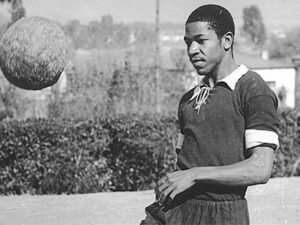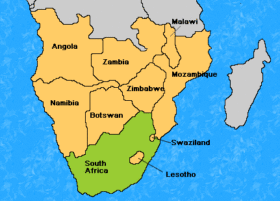As the sun rises on March 20, South Africa awakens to a new day and echoes its ever-evolving history. But what specific tales does this particular date whisper? We embark on a journey to uncover the threads woven into the fabric of March 20 in South Africa.

2015: South African football legend Steve Mokone died
Steve ‘The Black Meteor’ Mokone died in Washington, D.C., on March 20, 2015. He would go on to be one of the most recognized South Africans in the world because of the mark he made in football outside of our borders. Before his departure on October 21, 1955, to Coventry City, England, Dr. Willie Nkomo and Dr. Peter Tsele of the African National Congress gave him words of encouragement.
1999: The Azanian People’s Liberation Army (APLA) disbands
The Azanian People’s Liberation Army (APLA) was the underground military wing of the Pan African Congress (PAC). APLA was formed in the 1960s, after the banning of the PAC and other political organisations such as the African National Congress (ANC) and the South African Communist Party (SACP). APLA supported the PAC ideology of iZwe ngelethu, “Africa is Ours”, and Mayibuye iAfrika, “Bring back Africa”. APLA was associated with attacks on and murders of White South Africans. Most of these murders and attacks reportedly took place in the Eastern and Western Cape. According to the evidence of APLA victims before the Truth and Reconciliation Commission (TRC) most of these attacks and murders were random acts of violence and were not politically motivated. During the 1980s APLA came up with the provocative slogan of “One Settler, One Bullet”. Killings and attacks on White farmers were believed to be motivated by this slogan. On 26 July 1993 members of APLA opened fire on a congregation in St James Church in Kenilworth, in Cape Town, killing eleven people and injuring fifty others. The disbanding of APLA followed the TRC conclusion that the group had often acted with hatred rather than justice. Soon after these TRC findings, APLA disbanded.
1993: South African artist, Gerard Sekoto, dies
Gerard Sekoto was a South African artist and musician who is considered the pioneer of urban black art and social realism. He painted urban images of active scenes in the community in bold colours, in an expressionist style. He is known for being the first black artist to have a painting enter a museum collection. Sekoto played several musical instruments and left South Africa for Paris in 1947, where he worked as a pianist and composed 29 songs. His compositions were published by Les Editions Musicales, and he played piano and sang on several records.
1992: Presentation of South African National budget of 1991
The Finance Minister presented a budget in parliament offering a tax incentive to businesses, with an emphasis on the GDP. He proposed an expenditure of R85,000 million with cuts in deficit spending but an increase in social spending of 15%. To fund this increase, he announced an increase in value-added tax (VAT) for the first time, which would be added to all foods. The South African Police Service (SAPS) was to receive R4,600 million, a 53% increase. The African National Congress (ANC) criticised the budget, calling the proposed level of social expenditure hopelessly inadequate.
1983: Umkhonto we Sizwe bombs Church Street, Pretoria
One of South Africa’s deadliest terror attacks took place in Church Street, Pretoria, in 1983, when Umkhonto we Sizwe (MK), the armed wing of the African National Congress, detonated a large mortar bomb outside Nedbank Square in Church Street, a building that hosted the South African Air Force’s headquarters. The bombing resulted in the deaths of 19 people as well as over one hundred injuries. The bombing took the lives of 17 men and 2 women, of whom 9 were white and 7 were black. The bomb proved successful in its objective to cause the most harm, as its detonation time was 16:30 in the afternoon, a peak rush-hour for the area. MK forces participated in a range of various systematic bombings across South Africa during the years following the 1938 Church Street bombing. The African National Congress claimed responsibility for the bombing under the leadership of Oliver Tambo.
1982: The Conservative Party is formed
The Conservative Party (CP) was founded in Pretoria with Dr. Andries Treurnicht as leader. It brought together the National Conservative Party (NCP) and ‘Aksie Eie Toekoms’ (AET), a breakaway group from the National Party. The CP outlined fifteen guiding principles, including the idea that every group should have its own political structure. In the 1983 all-white referendum, the “no vote” advocated by the CP constituted 35.5% of the total votes.
1976: The Roman Catholic Church opens 192 all-white schools to black pupils
In South Africa, the Roman Catholic Church planned to open its all-white schools to black students, pending legal discussion with the government. However, three months later, over 20,000 Soweto learners protested against the use of Afrikaans in black secondary schools. The demonstration sparked a nationwide revolt, reinvigorating the fight for liberation in the country.
1953: First mountain zebra foal is born at National Mountain Zebra Park.
The Mountain Zebra is a unique and endangered species native to Angola, Namibia, and South Africa. There are two subspecies, the Cape Mountain Zebra and Hartmann’s Mountain Zebra, which developed due to hunting and habitat reduction. Overhunting brought them close to extinction, but the establishment of a Mountain Zebra Park in the 1930s proved successful in restoring their population. Today, there are around 9,000 mature individuals of this species, and they are being reintroduced to their former ranges.
1960: The Pondoland Revolts
The Pondoland revolt was a rejection of tribal authorities and self-government in Transkei. During a protest gathering in Bizana, tribal authority Saul Mabude refused to explain the Bantu Authorities Act of 1951, which angered the people who destroyed his house and livestock. Subsequent incidents led to the formation of a secret movement called Intaba (Mountain). Tension arose between activists and locals due to informers and violent treatment.
1902: 30 000 Blacks fight for Britain in Anglo-Boer War
During the Second Anglo Boer War, armed Blacks were employed in the British army. The perception of the war as a ‘White man’s war’ has weakened since the 1980s.
1896: The second Matabele war breaks out
The second Matabele War occurred on 20 March 1896 in Matabeleland, Zimbabwe. It was led by a spiritual leader named Mlimo who convinced the Ndebele that the British South Africa Company (BSAC), led by Cecil Rhodes, was the cause of the draught and locust plague destroying croplands. The objective was to drive the British out of the country, but when Mlimo was assassinated, Rhodes easily persuaded the warriors to surrender. Though hundreds of British soldiers lost their lives, the war did very little to change the lives of the indigenous people.



